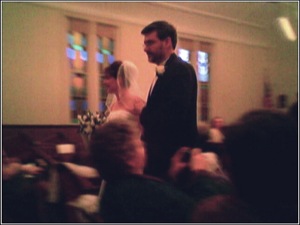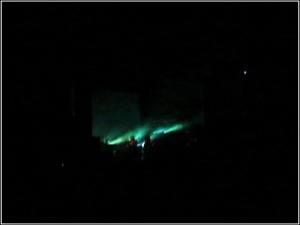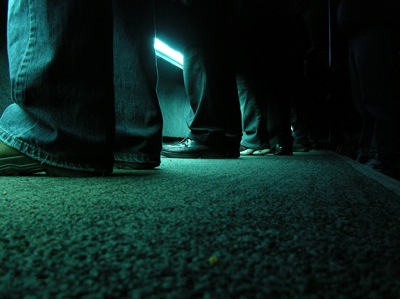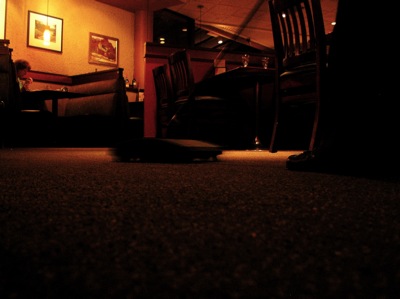15 May 2006 to 10 April 2006
The Boston-based photo-sharing site/service Tabblo just opened for public beta-testing, and I did a writeup about it for BostonWTF.com.
¶ Jim · 5 May 2006
Jim Moran completed his life last night. His doctors said he had four months left last July, and he decided to take ten instead. He was entirely himself right up to the very last days, and died at home with people who love him. Metastasizing cancer is an awful way to end, but now I know how much grace and dignity can be imposed on even that much awfulness.
I don't think Jim ever did use the walker they brought over for him a couple weeks ago, and I think he only agreed to the wheelchair that arrived last week because he could push it around with his eyes closed.
We opened the windows one day last weekend when it was nice out, so he could hear the birds in the trees outside his second-story window. I thought I spotted him inching the chair towards the door. I told him I was sorry that the wheelchair couldn't take him outside. He didn't say anything for almost long enough that I wondered if he'd heard. But then he opened one eye a little, peered at me skeptically, and slowly closed it again.
And then he said "What makes you think it won't take the stairs?"

I don't think Jim ever did use the walker they brought over for him a couple weeks ago, and I think he only agreed to the wheelchair that arrived last week because he could push it around with his eyes closed.
We opened the windows one day last weekend when it was nice out, so he could hear the birds in the trees outside his second-story window. I thought I spotted him inching the chair towards the door. I told him I was sorry that the wheelchair couldn't take him outside. He didn't say anything for almost long enough that I wondered if he'd heard. But then he opened one eye a little, peered at me skeptically, and slowly closed it again.
And then he said "What makes you think it won't take the stairs?"

¶ CD death-watch update 2 · 28 April 2006
Credit to both Metropolis and Nonesuch for not only responding to my emails, but promptly and uncomplainingly sending replacement copies of the Gary Numan and Stephin Merritt albums. Double credit to Metropolis for not minding that I had abused my first copy of Jagged fairly badly, trying out various supposed copy-protection circumvention techniques. Double credit to Nonesuch for not minding that I had returned my two copies of Showtunes, and they were thus sending me not so much a replacement as a free copy for my trouble.
Of course, both new CDs have exactly the same problem as the old CDs. They're defective pressings, not defective individual discs. Triple demerits to both labels for not having figured this out by now. Or for not admitting having figured it out, if in fact they have.
Of course, both new CDs have exactly the same problem as the old CDs. They're defective pressings, not defective individual discs. Triple demerits to both labels for not having figured this out by now. Or for not admitting having figured it out, if in fact they have.
I'm not sure if I think it represents inspired design, cynical design, or inspiredly cynical design, but I've been watching the iTunes Music Store with alternately grim and admiring fascination since they started allowing user comments. I thought it was a pretty terrible idea for them from the beginning. Apple has a strong corporate personality, and one of the only strongly positive corporate personalities, and diluting it with inevitably idiotic "reviews" seemed self-evidently awful to me. Amazon has had some success creating a body of mildly thoughtful annotation, but Amazon's music department is still oriented around selling CDs, so there's some remote hope that a person writing about an album may actually have heard it.
In the iTMS, however, not only are individual tracks sometimes more popular than whole albums, but even more significantly, it is central and trivial to listen to samples of all the material, which leads directly to the most uselessly write-only of all possible user contributions, the snap rating of albums based on first impressions of fragments of songs, by people who haven't even heard the whole thing once. It's debatable what function reviews have at all in the previewable era, but if they still have any role, surely it's to report back from extended experience with the music. If I can listen to the fragments myself, I don't need a second-hand version of that experience.
But the self-ratcheting structure of Apple's comment system applies some brilliant/crass social judo to automatically marginalize the crap. Under each comment is the telling question "Was this review helpful? Yes/No", and then the main page for each album shows only the first few reviews (6 if there's no "editorial" review, and only 3 if there is) as sorted by helpfulness. The all-reviews page begins with one recent review, to encourage new input, and then again defaults to sorting by helpfulness. Thus the farther a review falls down the helpfulness sort, the fewer people will even see it, and the less likely it is that it will be able to move back up. The worst crap, at least, sinks.
In the iTMS, however, not only are individual tracks sometimes more popular than whole albums, but even more significantly, it is central and trivial to listen to samples of all the material, which leads directly to the most uselessly write-only of all possible user contributions, the snap rating of albums based on first impressions of fragments of songs, by people who haven't even heard the whole thing once. It's debatable what function reviews have at all in the previewable era, but if they still have any role, surely it's to report back from extended experience with the music. If I can listen to the fragments myself, I don't need a second-hand version of that experience.
But the self-ratcheting structure of Apple's comment system applies some brilliant/crass social judo to automatically marginalize the crap. Under each comment is the telling question "Was this review helpful? Yes/No", and then the main page for each album shows only the first few reviews (6 if there's no "editorial" review, and only 3 if there is) as sorted by helpfulness. The all-reviews page begins with one recent review, to encourage new input, and then again defaults to sorting by helpfulness. Thus the farther a review falls down the helpfulness sort, the fewer people will even see it, and the less likely it is that it will be able to move back up. The worst crap, at least, sinks.




(four moments found in my cameraphone, which I never seem to remember having used)
Traffic seems to have slowed to a standstill on vF, my discussion forum. This is totally unsurprising, since the forum has never had any better reason to exist than me feeling like programming it, and I haven't done much to recruit conversants or stimulate conversation.
Nor will this really count as recruiting or stimulation, but today I finally got around to porting the search function used elsewhere on this site over to the forum software.
Please rejoice discreetly.
Nor will this really count as recruiting or stimulation, but today I finally got around to porting the search function used elsewhere on this site over to the forum software.
Please rejoice discreetly.
¶ alpha beta go · 13 April 2006 essay/tech
Say you're making software to do X. The audience for this is people who want to do X, and the evaluation criteria for the software to do X is that it actually can be used to do X in some respectable and hopefully distinguished manner.
Before you get to the released version of your software to do X, there are two useful stages you will probably want to pass through: beta and alpha. These are not percentages of completion or levels of toleration of error, they are themselves tools for different purposes than the released version. X beta exists to provide an evaluable preview of X. X alpha exists to provide an evaluable preview of X beta.
It is not only possible, but critical, to substitute these purposes of beta and alpha back into the original statement. Like this, for beta:
Note that this is different. The people interested in previewing a tool to do X are not necessarily the same people as the ones who want to do X, and their goal is not doing X but seeing how your software is going to do X.
Likewise with alpha:
That is, the beta is a tool for seeing how the real thing is eventually going to work, and the alpha is a tool for seeing how the beta is eventually going to work. The audience for alpha is thus double-meta, and is likely to be very small, sometimes even smaller than the team working on it.
Even more crucially, the substitution works in the other direction, too: beta is a released version of software for evaluating a preview of X, and the alpha is a released version of software for evaluating a preview of the beta. So while the X beta may have omissions and errors in its performance of X without failing, if it has omissions and errors in its performance of the evaluation and preview of X, it fails.
Thus the released version of an online calendar for shared scheduling, for example, fails if it can't be used for shared scheduling. But the beta fails if it can't be used for experimenting with shared scheduling. So the beta doesn't require that all the shared scheduling features work, but it does require that all the experimentation features are ready.
If your software involves manipulating user data of any kind, then, here are some things that probably have to be already working, without appreciable error, in your beta:
- import
- reimport
- importing useful sample data
- distinguishing data by import batch
- undoing import batches
- deleting data
- deleting data en masse
- full data purge and restart of beta experience
- comparing your treatment of this data to the treatment of it wherever it came from
- comparing different treatments of this data within your own software
- export/sync/feed of this data to any evaluation-critical downstream integration points
- sync/feed of source data from any evaluation-critical upstream integration points
- full operation of a representative subset of anything critical of which there will be multiples (integration points, environments, styles, templates, other users, etc.)
- any configuration settings integral to personal evaluation
- clear explanation of beta limitations
If any of these aren't done, don't ship your beta yet. If some of them aren't even in your design, you've got more designing to do.
Before you get to the released version of your software to do X, there are two useful stages you will probably want to pass through: beta and alpha. These are not percentages of completion or levels of toleration of error, they are themselves tools for different purposes than the released version. X beta exists to provide an evaluable preview of X. X alpha exists to provide an evaluable preview of X beta.
It is not only possible, but critical, to substitute these purposes of beta and alpha back into the original statement. Like this, for beta:
Say you're making software to {provide an evaluable preview of X}. The audience for this is people who want to {evaluate a preview of X}, and the evaluation criteria for the software to {provide an evaluable preview of X} is that it actually can be used to {evaluate a preview of X} in some respectable and hopefully distinguished manner.
Note that this is different. The people interested in previewing a tool to do X are not necessarily the same people as the ones who want to do X, and their goal is not doing X but seeing how your software is going to do X.
Likewise with alpha:
Say you're making software to {provide an evaluable preview of an evaluable preview of X}. The audience for this is people who want to {evaluate a preview of an evaluable preview of X}, and the evaluation criteria for the software to {provide an evaluable preview of an evaluable preview of X} is that it actually can be used to {evaluate a preview of an evaluable preview of X} in some respectable and hopefully distinguished manner.
That is, the beta is a tool for seeing how the real thing is eventually going to work, and the alpha is a tool for seeing how the beta is eventually going to work. The audience for alpha is thus double-meta, and is likely to be very small, sometimes even smaller than the team working on it.
Even more crucially, the substitution works in the other direction, too: beta is a released version of software for evaluating a preview of X, and the alpha is a released version of software for evaluating a preview of the beta. So while the X beta may have omissions and errors in its performance of X without failing, if it has omissions and errors in its performance of the evaluation and preview of X, it fails.
Thus the released version of an online calendar for shared scheduling, for example, fails if it can't be used for shared scheduling. But the beta fails if it can't be used for experimenting with shared scheduling. So the beta doesn't require that all the shared scheduling features work, but it does require that all the experimentation features are ready.
If your software involves manipulating user data of any kind, then, here are some things that probably have to be already working, without appreciable error, in your beta:
- import
- reimport
- importing useful sample data
- distinguishing data by import batch
- undoing import batches
- deleting data
- deleting data en masse
- full data purge and restart of beta experience
- comparing your treatment of this data to the treatment of it wherever it came from
- comparing different treatments of this data within your own software
- export/sync/feed of this data to any evaluation-critical downstream integration points
- sync/feed of source data from any evaluation-critical upstream integration points
- full operation of a representative subset of anything critical of which there will be multiples (integration points, environments, styles, templates, other users, etc.)
- any configuration settings integral to personal evaluation
- clear explanation of beta limitations
If any of these aren't done, don't ship your beta yet. If some of them aren't even in your design, you've got more designing to do.
Elsewhere, Brian Del Vecchio, Rod Begbie and I are, at Brian's inspiration and so far frankly with mostly his work, trying to get a group blog going about Boston-area new-technology developments. I knew the idea was brilliant as soon as Brian snagged the domain name BostonWTF.com.
¶ new job · 10 April 2006
I won't actually go back to work for a little while longer, but I now know where I'll be working once I do.
I really wanted, in the spirit of openness, to journal my job-search. I think we benefit from sharing our evaluations and processes and experiences, in general, and finding a new job isn't structurally all that different from the kinds of consumer decisions that it's already considered wholly appropriate to write about in public. Legally speaking, I was not under formal non-disclosure agreements anywhere I visited or interviewed, and morally it would have been trivial and narratively harmless to leave out the few specific details that were revealed to me in informal confidence.
But the big difference between consumer decisions and getting a new job, obviously, at least here in the part of the world where I buy and work, is that sellers don't get to choose their buyers, so consumer openness mostly doesn't introduce any risk of recoil. I could have written about my job-search anonymously (and for all you know, I did), but writing about it here would have put my thoughts into the awareness of my potential employers. That should be safe, in the same way that writing openly about your actual employers (short of definable trade-secrets, and that should be more carefully circumscribed and limited, too) ought to be much more rigorously defended. But some precedent still needs to be set, and I wasn't quite up to putting myself in the position to set it. Until I found a new job, I couldn't be sure that I wouldn't end up wanting or needing to take one about which I'd previously expressed reservations or criticisms.
In the end, though, my search turned out to be less contentious than I imagined it might. I walked out of more than one office thinking "Well, I'm not working there", but almost always due more to a mismatch of interests than any overwhelming sense of systemic dysfunction. I visited only one company that made me feel like I'd spent a day on the B Ark, and two of the most successful VC firms in the world had just expressed several million dollars of confidence in its commercial viability, so what do I know?
My search was also a lot less involved than I expected. This was the first time in my working life that I'd ever left one job without the next one already lined up, and really the first time I'd ever done a job search, as opposed to having a new job basically present itself to me at random. The overwhelming and unsurprising moral is that connections are everything. I spent a lot of time digging through public job-listings and refining filter subscriptions and sending off resumes to careers@... addresses, and nothing even marginally promising ever resulted from any of that. All meaningful leads came through people I knew. Weirdly, maybe, almost all my meaningful leads came through friends and colleagues, not former bosses, and in no case was anybody I know directly involved in the decisions about my role.
But I'd have spent even less time and energy on the process, and none pondering the ethics and repercussions of writing about it, if I'd known ahead of time that the very first casual job-related conversation I scheduled after being laid off, the connection to which came through my own sister, would end up leading to basically my dream job. This will probably be my easiest employer to explain, and my most arcane actual job. The company makes software for finding plane tickets, most prominently for the travel sites Orbitz, CheapTickets and Kayak, and the ticket-search functions on the airline sites for US Airways, Alitalia, Continental, and Alaska Airlines. The founder was recently listed by Travel & Leisure magazine as one of the 35 innovators who are changing the way people travel, and their blurb about him ended with this comment: "But it's Wertheimer's next undertaking that will most affect travelers. Called Project Needle (as in haystack), it uses artificial intelligence to search travel sites, quickly 'learning' them and giving shoppers only the information they're looking for."
I'm not at liberty to explain the exact relationship between this description and reality, but there is a real project to which they are referring, and I will be working on it. In casual conversation I will probably usually summarize it as "semantic web searching", which, depending on where you put the hyphen, has to do with either how to structure human information so that it can be better synthesized by machines, or how to teach machines to better help humans extract useful understanding from bodies of information not already structured that way. It will be a while before you get to see any form of this, and probably a while before I can even say what that form might be. But I believe it's one of the mutations that will shape the future evolution of the net, and I'm thrilled to get to participate in something I would spend so much of my energy pondering and following even if I weren't.
And although this could have been my dream job even if I'd had to move to California or Norway to do it, its most hilarious minor virtue is that the office is so close to my house that I think the single Walk light between here and there accounts for 20% of the variability in my commute time. In fact, coworkers who live elsewhere and drive to this office have to walk farther from their parked cars than I will from my bed.
But maybe the future is always closer than you think.
I really wanted, in the spirit of openness, to journal my job-search. I think we benefit from sharing our evaluations and processes and experiences, in general, and finding a new job isn't structurally all that different from the kinds of consumer decisions that it's already considered wholly appropriate to write about in public. Legally speaking, I was not under formal non-disclosure agreements anywhere I visited or interviewed, and morally it would have been trivial and narratively harmless to leave out the few specific details that were revealed to me in informal confidence.
But the big difference between consumer decisions and getting a new job, obviously, at least here in the part of the world where I buy and work, is that sellers don't get to choose their buyers, so consumer openness mostly doesn't introduce any risk of recoil. I could have written about my job-search anonymously (and for all you know, I did), but writing about it here would have put my thoughts into the awareness of my potential employers. That should be safe, in the same way that writing openly about your actual employers (short of definable trade-secrets, and that should be more carefully circumscribed and limited, too) ought to be much more rigorously defended. But some precedent still needs to be set, and I wasn't quite up to putting myself in the position to set it. Until I found a new job, I couldn't be sure that I wouldn't end up wanting or needing to take one about which I'd previously expressed reservations or criticisms.
In the end, though, my search turned out to be less contentious than I imagined it might. I walked out of more than one office thinking "Well, I'm not working there", but almost always due more to a mismatch of interests than any overwhelming sense of systemic dysfunction. I visited only one company that made me feel like I'd spent a day on the B Ark, and two of the most successful VC firms in the world had just expressed several million dollars of confidence in its commercial viability, so what do I know?
My search was also a lot less involved than I expected. This was the first time in my working life that I'd ever left one job without the next one already lined up, and really the first time I'd ever done a job search, as opposed to having a new job basically present itself to me at random. The overwhelming and unsurprising moral is that connections are everything. I spent a lot of time digging through public job-listings and refining filter subscriptions and sending off resumes to careers@... addresses, and nothing even marginally promising ever resulted from any of that. All meaningful leads came through people I knew. Weirdly, maybe, almost all my meaningful leads came through friends and colleagues, not former bosses, and in no case was anybody I know directly involved in the decisions about my role.
But I'd have spent even less time and energy on the process, and none pondering the ethics and repercussions of writing about it, if I'd known ahead of time that the very first casual job-related conversation I scheduled after being laid off, the connection to which came through my own sister, would end up leading to basically my dream job. This will probably be my easiest employer to explain, and my most arcane actual job. The company makes software for finding plane tickets, most prominently for the travel sites Orbitz, CheapTickets and Kayak, and the ticket-search functions on the airline sites for US Airways, Alitalia, Continental, and Alaska Airlines. The founder was recently listed by Travel & Leisure magazine as one of the 35 innovators who are changing the way people travel, and their blurb about him ended with this comment: "But it's Wertheimer's next undertaking that will most affect travelers. Called Project Needle (as in haystack), it uses artificial intelligence to search travel sites, quickly 'learning' them and giving shoppers only the information they're looking for."
I'm not at liberty to explain the exact relationship between this description and reality, but there is a real project to which they are referring, and I will be working on it. In casual conversation I will probably usually summarize it as "semantic web searching", which, depending on where you put the hyphen, has to do with either how to structure human information so that it can be better synthesized by machines, or how to teach machines to better help humans extract useful understanding from bodies of information not already structured that way. It will be a while before you get to see any form of this, and probably a while before I can even say what that form might be. But I believe it's one of the mutations that will shape the future evolution of the net, and I'm thrilled to get to participate in something I would spend so much of my energy pondering and following even if I weren't.
And although this could have been my dream job even if I'd had to move to California or Norway to do it, its most hilarious minor virtue is that the office is so close to my house that I think the single Walk light between here and there accounts for 20% of the variability in my commute time. In fact, coworkers who live elsewhere and drive to this office have to walk farther from their parked cars than I will from my bed.
But maybe the future is always closer than you think.




